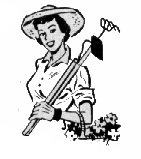

THERE may be some who think it is a little late to talk about winter protection of plants in December. Still, most growers agree that the critical tune for plants that are on the borderline of hardiness is in late winter when a warm sun, combined with drying winds, takes moisture from leaves and branches at a time when roots are unable to replenish it owing to the cold or frozen earth. Therefore, if you have procrastinated, do not worry about it, but on the other hand, do not delay much longer.
Pruning
Advantage should be taken of those days when it is comfortable to work out-of-doors to get busy with any pruning of trees and shrubs, which may be necessary. Getting an early start on pruning those trees that “bleed” if pruned in late winter or early spring is especially desirable. Although we are told that this bleeding does not harm, it prevents one from promptly applying a protective coat of paint to the wound. So, if you have maples that must be pruned, do it now or wait until midsummer. Dead and diseased branches should be the first to receive attention. Whether or not to cut off any of the healthy ones depends upon the purpose you have in view. If it is a matter of improving the tree’s symmetry, that can be done now, but if you have a tree growing too vigorously. If you wish to restrain it, waiting until the summer pruning would be better. In winter, it stimulates vigorous shoot growth, while summer pruning tends to cheek it.
Don’t prune shrubs indiscriminately.
Before pruning shrubs, one should know their flower-bearing habits well. Otherwise, harm rather than good may result. Most of the early blossoming shrubs start the formation of their flower buds in the fall, and any extensive pruning during the time that the bushes are dormant results in the diminution of the number of flowers produced the following spring. An excellent point to bear in mind when pruning is to be prone in such a way that the natural shape of the bash is maintained. Usually, this means that priming should be a thinning process restricted to removing dead and worn-out brandies.
Before disposing of the prunings via the bonfire, look them over to save any that are likely to be valuable next year as plant support. Many low-growing perennials of sprawling habit, such as Veronica, Teucrium, Potentilla, Coreopsis, and Gypsophila, can be more effectively and artistically supported using twiggy growth pushed into the grounds around them before they have completed their growth than they can be by the more usual method of stakes and twine. If the plant one wishes to support is to be grown in rows, making fan-shaped supports desirable, the prunings selected should be laid on the ground and weighted with a plank to press them to the required shape. If this is done relatively early in the winter, they will retain the desired form when the plank is removed before using them.
Pests
Those who live in sections bothered by tent caterpillars, gypsy moths, and tussock moths could advantageously spend a little time hunting for and destroying the egg masses of these pests during the winter. The mahogany brown ones of the tent caterpillar are found on young twigs in a band almost wholly encircling them. Usually, the most convenient way of getting rid of them is to clip off the twig with the eggs attached and destroy it by burning it. Gypsy moths and tussock moths lay their eggs in clusters. The mechanical removal of the eggs or daubing them with a paintbrush moistened with creosote is a valuable winter chore.
Any garden debris that might harbor insect or fungus pests and, therefore, is not suited for the compost pile should be destroyed by burning. This includes Peony tops, which may carry the botrytis fungus, and fallen Rose leaves, which harbor the winter spores of black spots.
Propagation
It is not too late to make hardwood cuttings of deciduous shrubs. As mentioned in a previous calendar (October), these should be cut 6 to 10 inches long, tied in bundles, buried in moist sand or peat moss, and kept cold, but not freezing, during the winter. If a greenhouse has available cuttings of evergreens such as Arborvitae, Taxus, Juniper, Teucrium chamaedrys, Box, and Euonymus, they can be inserted in the propagating bench.
Forced bulbs. Bulbs should be brought in at intervals from the planting pit outdoors for moving into the home or greenhouse. Do not expose them to a temperature that is too high at first. Give them a few weeks at a temperature of 50° and then raise it to 65°.
By C. Grayson

